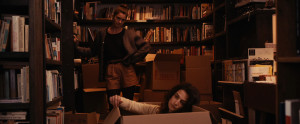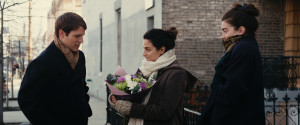Transformers: Age of Extinction is, in many ways, a new beginning for the Transformers film franchise. As the name implies, there is a subplot about how the Transformers arrived on a prehistoric Earth inadvertently causing the extinction of the dinosaurs (hence the inclusion of the Dinobots). Following the events of Transformers: Dark of the Moon, Optimus Prime and the rest of the Autobots have gone into hiding to avoid being hunted down by distrusting government officials conspiring to end their existence. And with Megatron and the Decepticons apparently gone, a new threat arises that threatens extinction for humanity and Transformers alike.
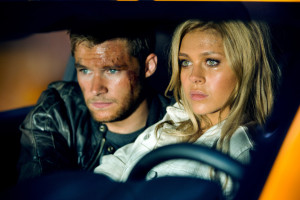
Jack Reynor and Nicola Peltz co-star in “Transformers: Age of Extinction”. Photo by Andrew Cooper.
Age of Extinction is also a rebirth of sorts for the franchise in that it has an entirely new cast of characters played by actors new to the Transformers universe. Having starred in Michael Bay‘s Pain & Gain last year, Mark Wahlberg heads up this new cast as Carl Yeager (see what they did there?), a muscled-up mechanic who spends most of his time tinkering around in his Texas barn, creating impressively useless things such as a robotic guard dog and a mechanical butler that can’t quite make it all the way to the couch with your cold beer. Wahlberg spends a majority of the film evading evil robots and corrupt CIA agents with his alluring teenage daughter Tessa (Nicola Peltz) and her charming race car-driving boyfriend Shane (Jack Reynor). So, there’s no shortage of attractive people running through explosions, a favorite of Bay’s. Though I wish I could have talked to them after seeing the movie (I can think of several more things to ask now that I’ve seen it), Wrestling with Pop Culture was more than happy to talk to Reynor and Peltz before their transformation from indie favorites to Hollywood action stars.
Age of Extinction is the fourth film in the franchise and some are saying it’s a reboot because of the new characters and new story. What do you feel you bring to this franchise?
Reynor: The first thing I’ll say is this is certainly a sequel to the previous films. It picks up four years after the war in Chicago, which was the end of the third film. Our characters are very different from the previous ones. The Autobots are very different to what they were in the previous series because they’re in exile. Humanity is aware of them now, but doesn’t understand them and is very intolerant of this alien invasion, as they would probably put it. So, the Autobots have gone into exile and are kind of weary about humanity’s flaws, Essentially, the character dynamic between Mark, Nicola and myself tries to restore their faith in humanity. That is really what’s at the heart of the film and that’s what grounds the film. It’s trying to bring a fresh emotional truth to this particular project and to add some more layers than might have been there previously. Hopefully that’s something that’s going to translate in the finished product. So, that’s where we’re coming from with this one.
Working with such elaborate effects and working so much with a green screen, what were the biggest challenges in having to imagine these characters around you?
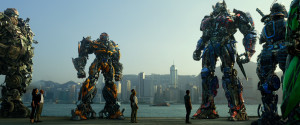
Photo by Industrial Light & Magic/Paramount.
Peltz: Going into the film, I thought there was going to be a lot of green screen. But there really wasn’t. Obviously, Bumblebee and Optimus and all the Autobots are all fake. But all of Michael’s car chases and explosions, that’s all real. These magnificent sets, he really builds or were actually there. So, the only thing that is green screen are the Autobots and Decepticons and Dinbots. You got to use your imagination; it’s a lot of fun. The only thing that I can say was the most challenging was when you have a scene where there are six robots and you just have to remember their eye-lines and almost memorize their lines and who is saying what so you know where to look. If we’re lucky, we get a silver pole [to look at]. If not, we get nothing.
Reynor: It’s funny because, like Nicola says, Michael makes all these explosions real, all these crashes real – all those big effects, most of them are practical. That’s something that’s very unique about his films and I think it’s responsible in no small part, perhaps, for the success of the films he’s made throughout the course of his career. That was a really great opportunity for us because we were shooting a big Hollywood blockbuster that wasn’t a green screen and it was very real and tangible for us while we were on set. At times it can be really terrifying. In terms of working with imaginary robots, when you’re an actor – be it in independent film, be it in television – you’re just asked to suspend your disbelief and draw on your imagination, draw on your emotions and these kinds of things. Giant robots are really just an extension of that. After a week or two of us being in this environment, we grew in confidence with Michael’s support and Mark’s support. Obviously, Mark shot Ted right before this, so he’s got an imaginary best friend. So, he was the first one to say, “Look, you guys just need to throw yourself in. It might feel silly to you, but if you’re not going to be the one to sell it on screen, the threat won’t translate and the intensity and action won’t be able to translate. It’s up to you to essentially convey all the emotion.”
As physically demanding as it is with all the explosions and stunts, did you guys go through any sort of training to prepare for that?
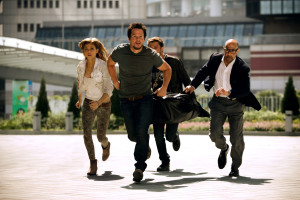
Peltz and Reynor do a lot of running in “Age of Extinction,” here with Mark Wahlberg and Stanley Tucci. Photo by Andrew Cooper.
Peltz: Yeah. We did boot camp for two months before filming. I’m so happy we did it because I did not realize how much running is involved. We were running all the time. I think there’s two scenes where we’re either sitting in a car or – we’re never walking, we’re always running. So, it was so helpful for us to get in shape and be ready for whatever was to come on set.
Reynor: The days can be long. They can be, like, 14-hour days and there are some days that you’re on all of that time. If you’re going to be able to get through it without just being chronically exhausted, you’ve got to go to the gym and work out and you’ve got to be kind of at your peak fitness mentally and physically. So, Nicola and I just worked out as much as we could and I worked out with Mark a fair bit during the course of the film. It was really helpful to me. It really is a process you need to go through when you shoot one of these movies.
This year is the 30th anniversary of Transformers. I don’t know if that has anything to do with the timing of this movie’s release. Obviously, these stories and characters have evolved and gone through several retellings, including the previous three films. Were either of you fans of the cartoons or comic books? If so, how did those Transformers stories influence your performances in this film?
Reynor: We would have both grown up with Transformers. I certainly, in Ireland, watched the animated series on TV as a kid and had a whole line of the toys that I played with. I was a big fan of the films, too. But I’ve always been interested in the culture of it. I think it started in Japan and you can see a lot of their culture invested in Transformers, especially in the animated series. It’s been interesting to watch it translated to America over the last 30 years.
Peltz: I definitely grew up with Transformers. I’m a huge fan of what Michael’s done with these films and I was really exited to be part of one.
What was working with Mark Wahlberg like?
Peltz: Working with Mark was amazing. Everyone knows how talented he is, but he’s such a professional. He’s so hardworking and such a nice guy. Us being so new to the business and being able to learn from him and work with him, we really are lucky. He’s taught us a lot and I can’t say enough nice things about him. He’s great.
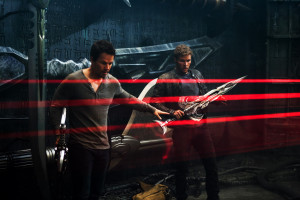
Wahlberg (left) and Reynor in “Age of Extinction”. Photo by Andrew Cooper.
Reynor: Yeah. He is a great dude. He’s really committed to what he does and very dedicated, like Nicola says. For us as young actors, we both come predominantly from an independent film background – Nicola’s obviously had [The Last] Airbender and stuff, but I came straight from independent film – and to watch Mark in a Hollywood blockbuster environment and see his ability to relate to it in a meaningful way and how it relates to him informed our work ethic and aspirations and goals for ourselves and how we would want to go about them.
Being young actors coming from these independent backgrounds, how is it to join such a huge summer blockbuster franchise?
Peltz: Like we said, we are big fans of Transformers. So, it’s really exciting for us. When we found out they were even casting someone our age it was exciting. But to now be part of it and work with the people who created such amazing films like the first three is really exciting.
Reynor: I find it very difficult to make a comparison between independent film and blockbusters. It’s two completely different schools of thought and two different animals. It’s funny because I can relate to the filmmaking process while I’m there and doing it, but now that it’s being released and I’m seeing ads on TV and stuff, it’s almost like I don’t see myself in it. Maybe it hasn’t hit me yet, maybe it never will. I don’t know. It’s just a weird thing that I find it difficult to relate to in a way. But I’m still very proud to be part of it and I’m very glad to be here. It’s done incredible things for my career since I shot it, so long may it continue.
What were your initial reactions to seeing the trailers and stuff being that when you were filming it you had to imagine everything?
Peltz: It’s honestly insane. I remember specifically this one scene where it looks like Michael is [moving] a green rake. In the scene, I’m screaming and it just felt really silly. But I saw the scene for the first time finished with the CGI and it is crazy. I was not there with that robot, I was there with Michael and a rake. It’s just crazy how they made that. The technology these days is honestly mind blowing. It’s crazy.
Is there a particular scene you’re excited to see in the film?
Reynor: I think there’s a few. There’s one scene that I really enjoy in the film. At the heart of the film is this dynamic of Nicola and her transition from family life and living under her father’s roof to becoming an independent woman and having a relationship with this guy. There’s a scene where we’re on the [Silver Bullet Zephyr] train in a trainyard, sleeping for the night. It’s a really nice scene where Nicola’s asleep at the back and Mark and I are on our own. We’re very quiet and he just starts to explain that he’s not going to be around forever and he needs somebody to look after her and she’s not going to be able to do it all on her own. I don’t really say anything to him in the scene, but it’s a nice moment and a nice relief from all the intensity, action and insanity where everything quiets down for a minute. It’s a really important moment in the film, so I’m really excited to see that scene.
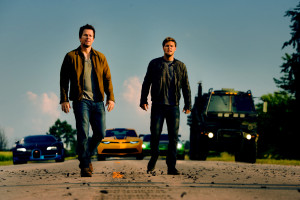
Photo by Andrew Cooper.
I’m excited to see that one massive explosion, which is going to be great. The final scene is beautiful, as well. We shot it Hong Kong harbor. Just aesthetically it’s so beautiful because Michael Bay knows how to capture sunlight like nobody else. Right at the end of the film, as we were shooting in Hong Kong harbor on the last day, the sunlight as the sun was going down was that Oriental red fireball in the sky. It just looked so incredible, so I think that’s going to look beautiful with the city as the backdrop.
Peltz: Like Jack said, Michael does action films like no other. It’s amazing to watch, and exciting. But in this film there are wonderful moments people can relate to and there’s a great human element to it. So I’m really excited to see those little moments as well as the crazy action scenes.
Were you under a lot of pressure to get it done right in the first take since you really only have room for one massive explosion?
Peltz: There was this one big explosion where the three of us are running and we had no warning. We got on set and we see these explosives everywhere and we see ten cameras, then Michael was like, “We’re doing this big explosion. It’s going to be you, Jack and Mark and you’re going to have to run from here to here in 4.6 seconds. You get a practice run. It took them a week to do it, so you can’t mess this up. It’s a one-take thing. Are you guys ready? You can’t mess this up.” It sounds so simple to run from here to here: all you’re doing is running. But it’s a lot of pressure and your adrenaline is through the roof. But it’s so fun when you’re in the moment and everything is just exploding around you.
Reynor: It’s not hard to sell in that moment.
Peltz: You feel the heat and it’s crazy. I would [otherwise] never experience anything like it. I’ve heard so many stories about how fast Michael moves on set and everything, but you almost have to experience it. That was really a fun day and crazy pressure.
Have you had a chance to give much thought to how being in this movie will affect your careers, especially given what being in the previous three movies did for those actors?
Reynor: I’ve been incredibly lucky. I haven’t stopped working since we made this movie. I’ve shot three films back to back since Transformers. One of them was an independent Irish film that I’ve wanted to finance for about a year and a half before I did Transformers with Toni Collette called Glassland, which was great. I moved on and made Macbeth with Michael Fassbender and Marion Cotillard, which was an incredible experience. Then I just made a movie there called Girls’ Night Out with Sarah Gadon and Bel Powley. It’s a fun movie about VE Day in 1945 in the U.K. So, even without Transformers being released, it’s given me an awful lot of ammunition in the industry and helped me to broaden and expand my career the way that I want to. I’m very grateful to the franchise for that, on top of many other things.
Coming from more dramatic pieces and coming into an action film like this, is there any difference in the way you approached this action role as opposed to your more dramatic roles?
Peltz: The great thing about acting, if we’re lucky enough, is we get to play a bunch of different characters. I approach each character differently because they’re different characters. But I didn’t approach this one differently just because it was an action film; I did because it’s just a different character than I’ve played before.
Reynor: I don’t think it’s a case of I’m taking off my drama hat and putting on my action hat. There’s a lot of really nice dramatic moments in the film and you still have to play those with the same kind of truth and commitment to the seriousness of an independent or dramatically-heavy film. That is an element of it, and at the same time you have to prepare yourself for the physicality of the action and the precision of shooting big, long action sequences.
www.transformersmovie.com


